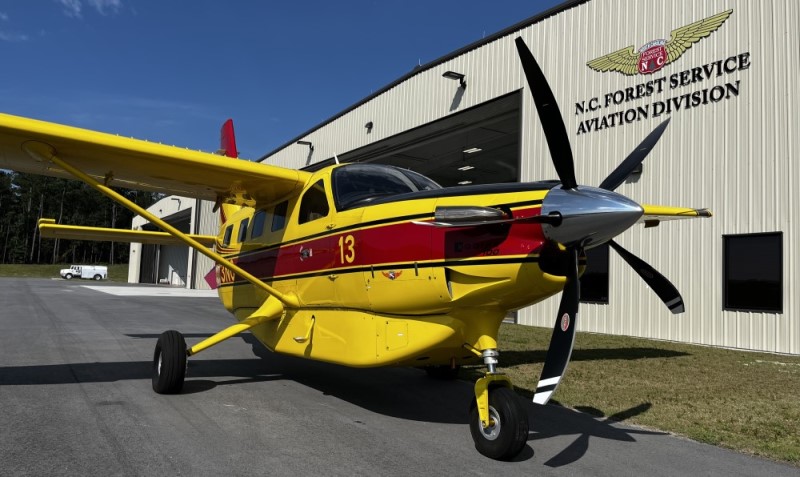
Daher’s first Kodiak 100 delivered with a five-blade composite propeller is shown at the North Carolina Forest Service’s Aviation Division at Duplin County Airport, Kenansville.
Daher has delivered a turboprop-powered Kodiak 100 to the North Carolina Forest Service’s Aviation Division, which becomes a new customer as well as the initial operator of this multi-mission aircraft equipped with a composite five-blade propeller.
The North Carolina Forest Service will utilize its Kodiak 100 as a “load aircraft," which carries equipment and supplies to operational locations in support of aerial tankers in the wildfire suppression role.
This is Daher’s first new-production Kodiak 100 to be delivered with the composite five-blade propeller configuration from Hartzell Propeller, enhancing the aircraft’s performance and further improving its sustainability.
“As North Carolina’s motto is: ‘First in Flight,’ it’s extremely appropriate that the state’s Forest Service is the initial operator of this latest upgrade for the Kodiak 100,” stated Nicolas Chabbert, the Senior Vice President of Daher’s Aircraft Division.
Tailored specifically for use on the Kodiak 100, the new five-blade propeller incorporates Hartzell’s lightweight Raptor propeller hub technology. The entire unit weighs 13 lbs. less than the Kodiak 100’s current four-blade metal propeller and reduces the aircraft’s takeoff roll by six percent at maximum gross weight. The propeller is durable by design, with a TBO (time between overhaul) of 4,000 hours/six years, and an industry-leading warranty of six years or up to 4,000 hours.
New-production Kodiak 100 Series III aircraft are now available with the five-blade composite propeller as an option. The retrofit for all in-service Kodiak 100s is offered via the Hartzell Top Prop program.
“We welcome the Kodiak 100 to the family of aircraft equipped with our five-blade composite propeller, joining Daher’s Kodiak 900 and the TBM 960,” said Hartzell President JJ Frigge. “Hartzell has been producing composite blades since 1978, which are made with a structural carbon fiber that offers superior strength, damage resistance, and reparability.”
Key features of Hartzell’s composite propeller blades include a durable nickel-cobalt leading edge, a nickel erosion screen for FOD (foreign object damage) protection, urethane paint for improved erosion protection, and the use of aerospace-grade carbon fiber.
The Kodiak 100’s new propeller is 6.6 dB quieter, turning at 2,000 rpm for maximum torque – which is 200 rpm slower than the current four-blade metal propeller. This slower rotation speed also reduces vibration aboard the aircraft and lowers the Kodiak 100’s flyover noise below the European EASA airworthiness authority’s stringent 78 dB(A) requirement.
At a diameter of 96 inches, the five-blade composite propeller has a ground clearance of 16.4 inches, retaining the Kodiak 100’s ability to operate from unprepared strips and in the amphibious version when equipped with floats.
Daher’s Kodiak 100 is a multi-mission workhorse, operated worldwide in applications that range from wildfire suppression, the monitoring of national resources and the protection of public safety to humanitarian services and ISR (intelligence, surveillance, and reconnaissance) duties. Of the total 320-plus Kodiak 100s delivered to date, more than 90 are in service with multi-mission operators, logging an estimated 28,500 flight hours annually for this fleet segment.
“With its enormous useful load, off-airport capabilities, and simple and rugged design, the Kodiak 100 is ideal for such a broad range of applications,” said Paul Carelli, the Director of Kodiak Flight Operations and Special Missions. “In addition to the performance improvement with Hartzell’s five-blade composite propeller, the aircraft is extremely quiet. This is significant for missions such as forestry and law enforcement, and also is very important when flying recreationally in backcountry environments.”









